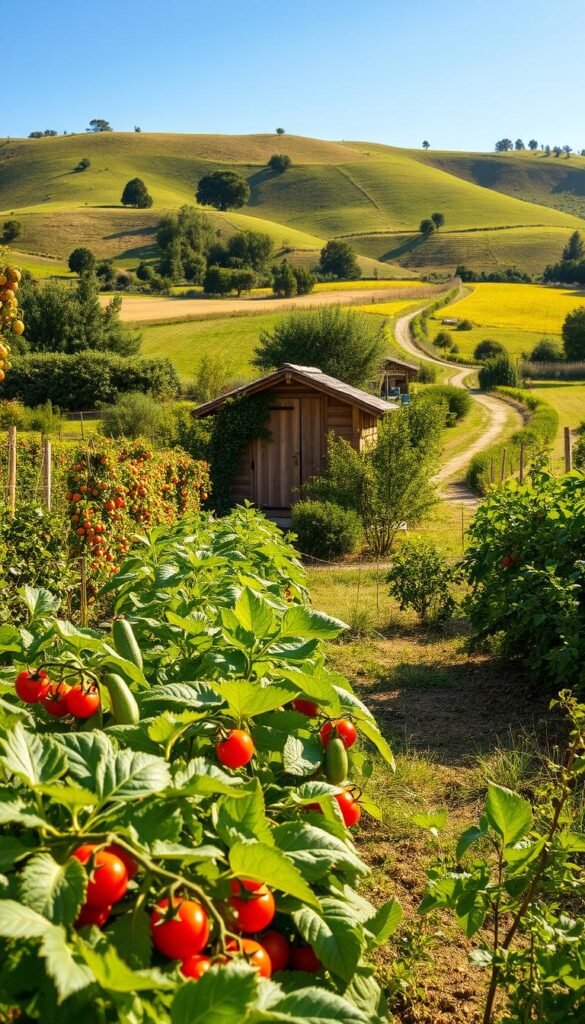Imagine growing juicy peaches alongside your tomatoes or apples shading your leafy greens. This space-smart approach blends fruit trees with vegetables to create living partnerships that benefit your entire growing space. Many gardeners are discovering how these strategic combinations can boost harvests while reducing common challenges like pests and soil depletion.
Through companion planting techniques, you’ll learn to design layered growing systems that mimic natural ecosystems. These methods help plants support each other – taller trees shelter delicate crops, while flowering varieties attract pollinators. Your garden becomes a self-sustaining network where every element serves multiple purposes.
Modern growers achieve up to 40% higher yields by integrating their plantings compared to traditional row gardening. You’ll discover how to select compatible species, arrange plants for optimal growth, and maintain balanced soil nutrition. Even small yards can produce surprising amounts of food when using vertical space and smart crop rotation.
This guide reveals practical steps to evolve your current setup into a high-efficiency food production area. We’ll explore sunlight management, root system coordination, and natural pest control through biodiversity. Get ready to harvest more with less effort while creating a beautiful, functional outdoor space that thrives season after season.
Introduction: Cultivating Your Mini-Farm Dream
Picture plump strawberries sharing soil with crisp lettuce, while dwarf apple trees tower above your pepper plants. This space-efficient strategy turns every square foot into a powerhouse of fresh food. Your journey begins by reimagining what a garden can achieve when plants work together like pieces of a puzzle.
Sweet basil shows how smart choices matter. Its compact size and pest-repelling aroma make it perfect for tight space. You’ll focus on plants that serve multiple roles – providing harvests while improving soil or deterring pests. Think cherry tomatoes climbing trellises beside bush beans, or blueberries shading heat-sensitive greens.
Successful small-scale growing isn’t about cramming more plants. It’s about selecting high-performance varieties that thrive in close quarters. Dwarf fruit trees, vertical cucumbers, and container-friendly root vegetables become your allies. These choices let you layer plants vertically and horizontally, mimicking nature’s efficiency.
Your outdoor area transforms into a living system where flowers feed pollinators, herbs repel bugs, and taller plants create microclimates. This approach boosts productivity while reducing maintenance. Even beginners can create these symbiotic relationships using proven combinations that thrive in US growing zones.
Essential Tips for Transforming a Vegetable and Fruit Garden into a Thriving Mini-Farm
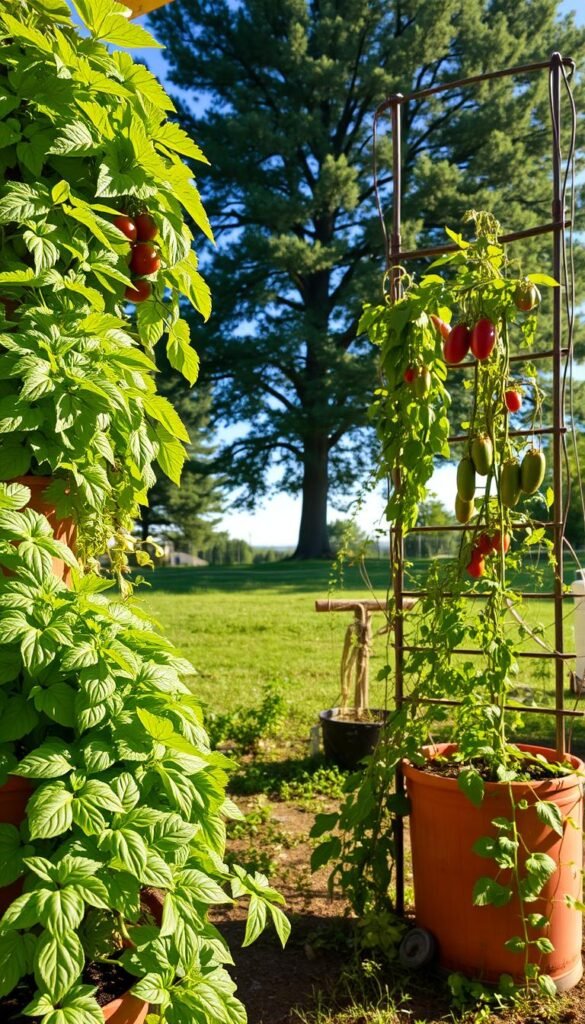
What if your backyard could yield restaurant-quality ingredients year-round? Start by sketching a three-dimensional layout that uses vertical space for climbing beans and dwarf fruit trees. This approach lets you grow 2-3 times more food without expanding your plot.
Smart growers prioritize double-duty plants like raspberries (food + privacy screens) and nasturtiums (edible flowers + pest control). Pair early spring greens with heat-loving peppers to maximize bed usage. “Rotating crops every 60 days keeps soil lively and pests confused,” notes urban farmer Lisa Chen.
Your secret weapons:
- Stagger plantings every 2 weeks for continuous harvests
- Use trellises to create shade for cool-weather vegetables
- Test soil annually and amend with compost tea
Create microclimates by positioning tender fruit bushes near south-facing walls. These thermal masses radiate heat at night, protecting plants from frost. Drip irrigation systems cut water use by 40% while keeping leaves dry to prevent disease.
Start small – convert one raised bed this season using these techniques. Track what works before expanding. Your garden will gradually become a self-renewing living pantry that feeds both body and soil.
Maximizing Garden Productivity with Integrated Ecosystems
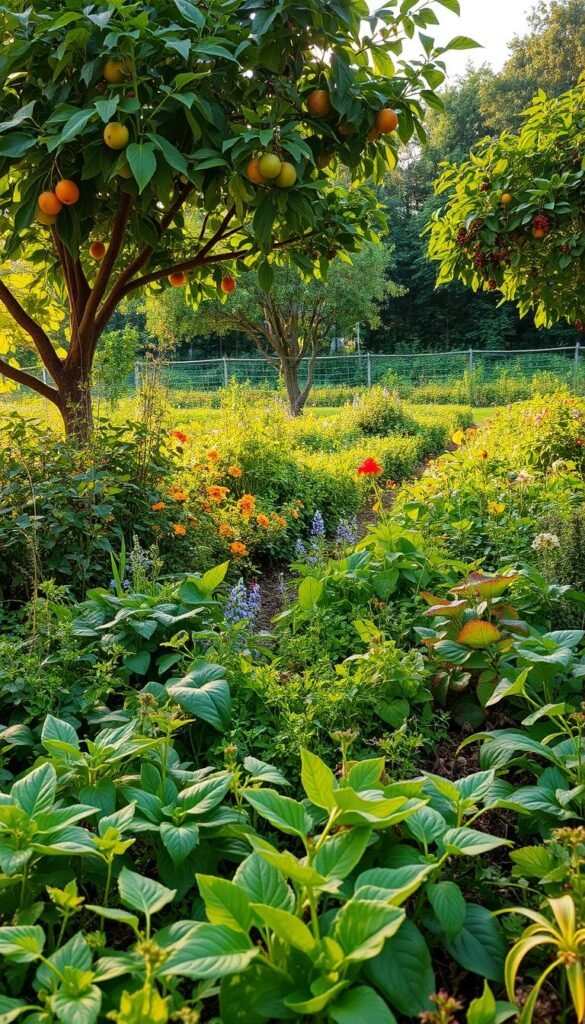
Think of your outdoor space as a multi-level food factory where every plant plays a vital role. By blending fruit trees with vegetables, you create living towers of abundance that outperform traditional row planting. This layered approach lets your garden work smarter, not harder.
Enhanced Yield Strategies
Start by pairing plants that share resources wisely. Tall fruit trees offer dappled shade for heat-sensitive greens below, while their fallen leaves enrich the soil. Flowering herbs between vegetables attract pollinators that boost fruit set in nearby plants.
Try these powerhouse combinations:
| Aspect | Traditional Garden | Integrated System |
|---|---|---|
| Space Use | Single layer | 3+ vertical layers |
| Yields | 1 harvest season | Continuous picking |
| Maintenance | Weekly weeding | Self-mulching |
| Biodiversity | 5-8 species | 15+ varieties |
Vertical Growing Benefits
Turn fences into food producers with espalier apple trees. Train pole beans up peach tree trunks – the legumes fix nitrogen while the fruit tree provides support. This space-saving trick lets you grow 3x more food without expanding your plot.
Compact varieties work best for vertical systems. Columnar blueberries make perfect edible hedges, while dwarf citrus thrives in large containers. Remember to rotate crops seasonally to maintain soil health and prevent pest buildup.
Boosting Soil Health and Fertility
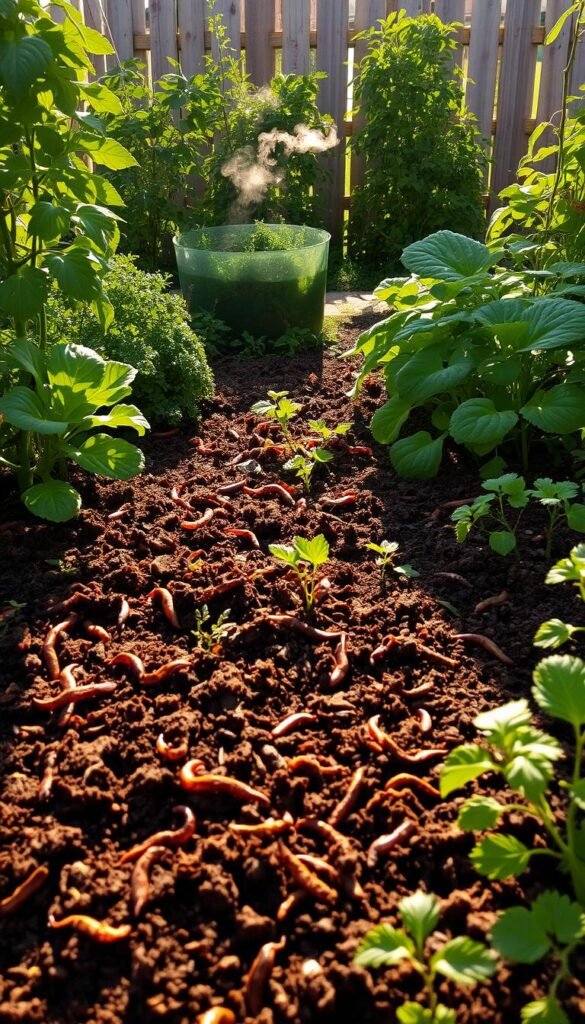
Healthy soil acts like a living pantry, storing nutrients your fruit trees and vegetables need to thrive. Through smart management, you create self-renewing systems where plants feed the earth as they grow. This natural cycle reduces upkeep while increasing harvests.
Nutrient Management Techniques
Deep-rooted fruit trees mine nutrients from subsoil layers, sharing them with shallow-rooted companions through fallen leaves. Annual compost applications (1-2 inches) maintain balanced nutrition without chemical inputs. Test your soil every spring to adjust amendments.
Try this comparison for smarter feeding:
| Method | Traditional Garden | Integrated System |
|---|---|---|
| Nutrient Source | Bagged fertilizer | Tree roots + compost |
| Water Retention | Daily watering | 65% less runoff |
| Organic Matter | Seasonal additions | Continuous leaf mulch |
Effective Mulching Strategies
Wood chips around fruit trees (3-4 inches deep) suppress weeds while slowly releasing nutrients. Keep mulch 6 inches from trunks to prevent rot. For vegetables, use straw or shredded leaves at 2-inch depth – these lighter materials won’t compact soil.
Your garden becomes a composting machine when tree leaves decompose between plants. This free mulch regulates temperature, retains moisture, and feeds earthworms. Over time, you’ll notice richer soil texture and fewer pest problems.
Leveraging Beneficial Microclimates
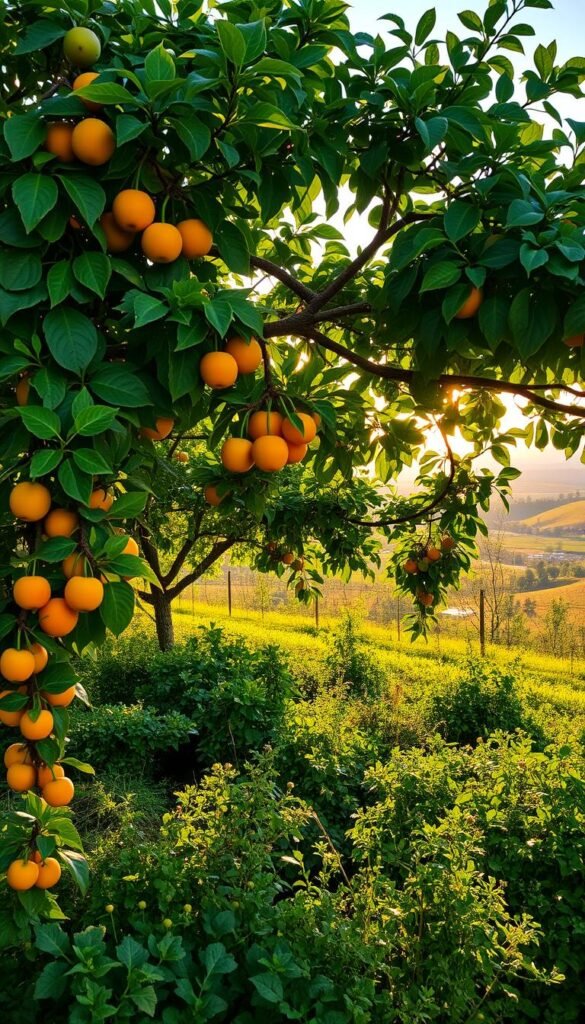
Did you know your fruit trees can double as climate controllers for nearby vegetables? These natural regulators create pockets of ideal growing conditions that boost plant health and yields. By understanding these micro-environments, you’ll turn weather challenges into growth opportunities.
Shade and Windbreak Benefits
Strategic placement of fruit trees shields tender crops from harsh elements. Their canopy reduces wind speed by 50-70%, preventing snapped stems in young seedlings. During heatwaves, dappled shade lowers soil temps 10-15°F – perfect for spinach and peas that bolt in direct sun.
Try these smart setups:
- Plant dwarf cherries north of lettuce beds for afternoon shade
- Use pear trees as living walls against prevailing winds
- Position berry bushes to filter harsh midday sunlight
Morning sun warms east-facing beds first, while west areas enjoy gentler afternoon rays. Measure your garden to find 5-8°F variations – these microclimates let you grow cool-weather crops longer. Sheltered zones need 30% less water thanks to reduced evaporation.
| Area | Exposed | Sheltered |
|---|---|---|
| Soil Temp | 85°F | 72°F |
| Water Loss | 1″ weekly | 0.7″ weekly |
| Wind Speed | 15 mph | 5 mph |
Your garden becomes a patchwork of perfect conditions. Heat-loving tomatoes bask in open spots, while shaded zones host successive plantings of arugula. This spatial planning lets you harvest 3x longer from the same ground.
Strategic Garden Layout and Sunlight Management
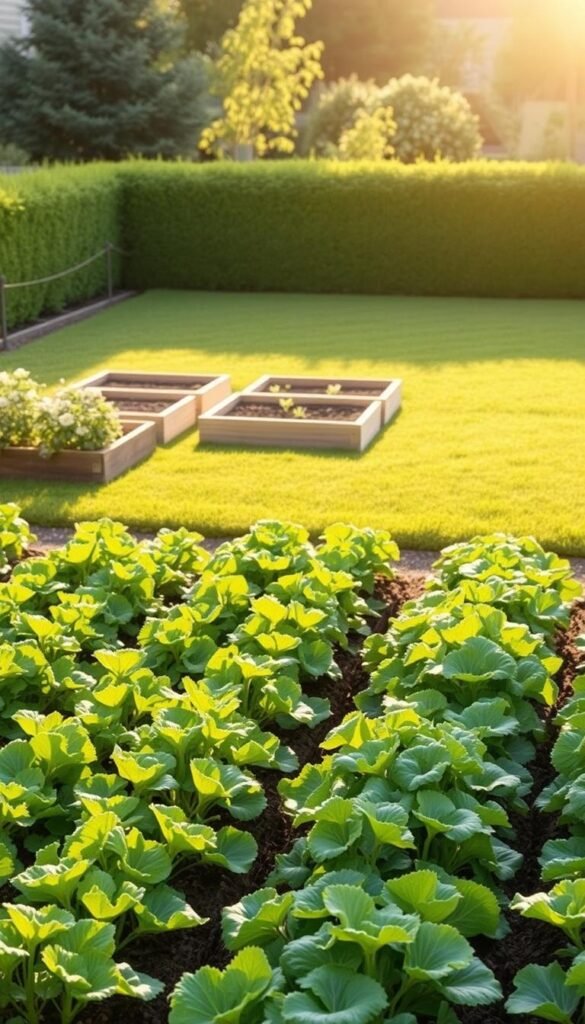
Did you know proper sunlight management can double your harvests? Your fruit trees and vegetables need different light levels to thrive. By mapping your space like a sunlight detective, you’ll create ideal growing conditions for every plant.
Mapping Sun Patterns
Track sunlight movement across seasons using free apps or simple stick markers. Most vegetables crave 6-8 hours of direct light – position these zones south of taller plants. Note how morning sun differs from afternoon intensity when planning planting areas.
Deciduous fruit trees make perfect natural umbrellas. Their summer leaves shield heat-sensitive crops, while bare winter branches let sunlight reach cold-hardy greens. Sketch shadow patterns at 9 AM, noon, and 3 PM to find sweet spots.
Managing Shade Zones for Vegetables
Create cool retreats for lettuce and spinach using dwarf plum or peach trees. These compact varieties cast shifting shade that prevents bolting in summer heat. Leave 10-15 feet between tree trunks and shade-loving crops for root space.
North-side tree placement protects sun-hungry tomatoes and peppers from shadow invasion. Use graph paper to design winding paths that maximize light access while allowing easy harvests. Your garden becomes a sunlight symphony – each section playing its part in the seasonal rhythm.
Mastering Companion Planting for a Balanced Ecosystem
Your growing space becomes a living puzzle where each plant plays a vital role. Strategic pairings create natural alliances that boost yields and deter pests. By matching fruit trees with helpful neighbors, you build resilient systems that thrive with minimal intervention.
Power Partnerships for Growth
Legumes like peas and beans work overtime near fruit trees. Their roots add nitrogen to soil while producing edible crops. Flank apple trees with garlic or chives – their strong scents repel borers naturally. For container setups, try companion planting in containers with mint and strawberries.
Herbs serve as garden bodyguards. Lavender between stone fruits confuses moths, while thyme attracts predatory wasps that eat aphids. These aromatic defenders create safer spaces for vegetables to flourish.
Problematic Plant Combinations
Some species clash like mismatched roommates. Keep nightshades (tomatoes, peppers) away from stone fruits – they share diseases through soil. Tall sunflowers steal light and nutrients from dwarf trees, stunting growth.
Brassicas release chemicals that hinder fruit tree roots. Separate cabbage family plants by at least 15 feet. With smart spacing and pairings, your garden becomes a self-regulating haven where plants protect and nourish each other.

